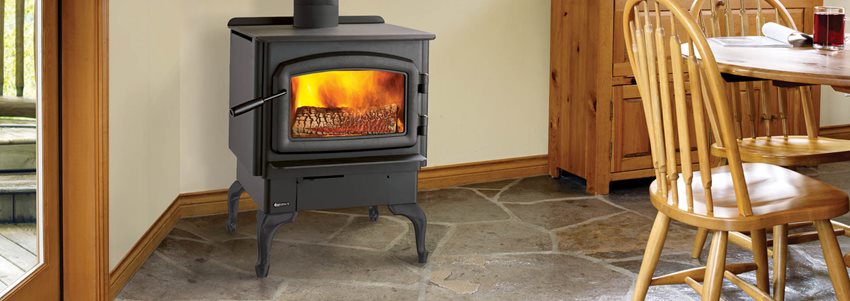
What are Burn Times?
A burn time is the total amount of time a single load of wood will burn from ignition through to smoldering. This includes from the time you light a heater, to when the coals are hot enough that you can add another log and the fire ignites again (without having to use another match). Burn time does not refer to the amount of time a piece of wood will display visible flames and be producing large amounts of heat (MJs).
How Burn Times Work
There is a lot of confusion around the concept of burn times for wood burning fireplaces, freestanding heaters, and inbuilts. While the idea seems straightforward, in reality, it is anything but. A burn time refers to the maximum amount of time a wood unit will burn from a single load of wood. This seems simple right? Put a log in and measure how long it burns, therefore that is the burn time. Unfortunately, it is not that straightforward and there are a number of factors that affect burn times, the most influential being the fireplace settings – burning on high vs burning on low.
When looking at a fireplace you will likely see two key elements – Megajoules per Hour or MJs (heat output) and burn time (total duration). Typically, consumers think the stated MJs of a unit are the number of MJs that the unit will always produce, when in fact it is the maximum output. The same goes for burn times, it is the maximum a fireplace can burn for under ideal conditions, not the average duration.
These numbers are highly related and depending on how a unit is burned a consumer can maximize the MJs, maximize burn time, or end up somewhere in the middle, but they can never have both. Typically, MJs are listed at their maximum or High Heat Value (HHV) and burn times are listed at their maximum or Low Heating Value (LHV).
For example:
- A fireplace burning on high (HHV) will produce 58 MJs and burn for a duration of 2.5 hours.
- The same fireplace burning on low (LHV) will produce 19 MJs and burn for a duration of 8 hours.
Therefore, the units
listed max MJ will be
58 and the
listed burn time will be
8 hours. The fireplace is capable of doing one or the other, however will not be able to do them at same time. HHV fires result in quick and hot burns that rapidly use fuel and LHV fires result in slow, stable, less intense burns that lengthen the fuel consumption.
Watch: Regency Non-Catalytic Wood Freestanding Heater burn for 10 hours
Note: The video above shows a North American Model burning and is for demnstrative purposes of total burn time only.
Factors Affecting Burn Times
Many different factors affect the burn time of a wood burning heater, fireplace, or inbuilt. Aside from the design and model of the fireplace, the following are the most influential factors for burn times:
Type of Wood
Different wood types will yield longer, hotter burns, while some will yield cooler and shorter burns. Typically, hardwoods like oak, walnut, and cherry burn longer than softwoods such as pine and fir.
Moisture Content
Wood with high moisture content will have less lengthy burns and very high moisture content can cause damage to the fireplace, freestanding heater, or inbuilt. The lower the moisture content the longer burn times you will receive. Make sure to always burn only
properly seasoned wood to avoid damage to the unit. There should be a moisture content of below 20% in wood used for burning.
Burn Settings
An air damper setting that is wide open (no restriction) will cause the fireplace, freetanding heater, or inbuilt to burn very hot and short as the fire is able to consume as much oxygen as it wants, therefore using all the available fuel quicker. For longer burns, restrict the airflow to the fire to draw out the length of the fuel burning. Low airflow fires will burn at a lower MJ output for long periods whereas high airflow fires will spike with a quick rush of MJs and quickly burn out, requiring additional wood.
Installation
The installation of a wood heater, fireplace, or fireplace inbuilt can dramatically affect the burn times. If the venting travels too far or the unit is incorrectly installed there will be a decrease in performance. To ensure your Regency wood unit is properly installed always contact a
certified Regency fireplace retailer or installer.
Climate Conditions
The altitude and humidity also affect the burn times of fireplaces. Higher altitudes decrease the burn times of most fireplaces as there is less available oxygen and the efficiency is decreased. High humidity also decreases burn times. The moisture in the air decreases the fire’s efficiency and lowers the expected burn times.
How to get your fireplace to burn as long as possible
The following is the best practices to ensure a long, warm fire for as long as possible:
- Use only well-seasoned wood
- Burn hardwood
- Fully load the firebox
- Set air damper to ‘low airflow’ setting
- Sit back, relax, and enjoy hours of warmth!
Longest Burning Wood Heaters
Typically catalytic or hybrid wood heatersproduce the longest burn times. Catalytic heaters produce long-term stable heat outputs due to their design and the nature of a catalytic combustor.